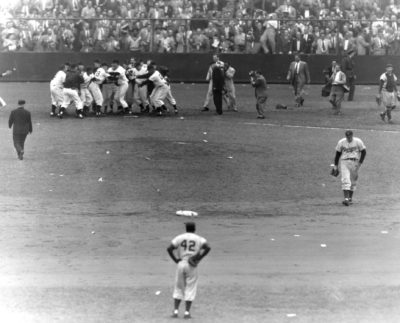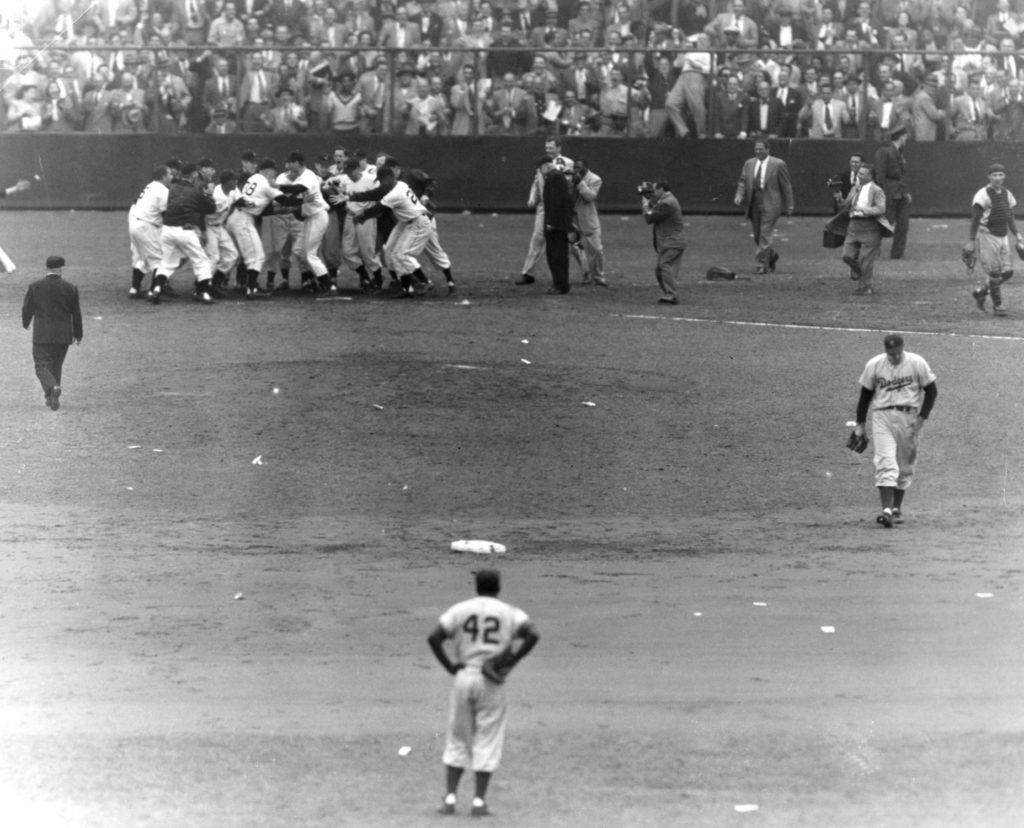Subscribe to Baseball History Comes Alive! to receive new posts automatically
“The Shot Heard Round the World” Photo Gallery
Click on any image below to see photos in full size and to start Photo Gallery:

Author Bill Gutman Talks About “The Shot Heard ‘Round The World!”
In recent years much has been written about Bobby Thomson’s “Shot Heard Round the Word” which gave the Giants victory over the Dodgers in their three-game playoff series, and ultimately, the 1951 pennant. It’s one of the most famous moments in baseball history.
In 2001, Wall Street Journal writer Joshua Prager first broke the “bombshell” news that Giants were stealing the Dodgers’ signs, which started in the second half of the 1951 season. Manager Leo Durocher had apparently concocted an elaborate scheme involving a “spotter” in the Polo Grounds’ scoreboard equipped with a powerful spyglass. An electronic means was used to buzz a pre-arranged signal to the bullpen, which was then flashed to the batter at home plate. Prager’s assertion had the effect of diminishing Thomson’s historic achievement and the Giants’ dramatic victory.
I recently had an interesting e-mail exchange with Bill Gutman, co-author of the 1991 book, The Giants Win the Pennant! The Giants Win the Pennant! Bill had done extensive research on the Thomson homer, including interviews with all the principals involved. I found it refreshing to have an intelligent discussion with someone who actually knows a thing or two about it.
Supposedly Bobby Thomson benefited from the scheme because he knew Dodger’ reliever Ralph Branca’s second pitch would be a fastball. Thomson always denied the charge. He maintained he was concentrating much too hard at the plate to be looking for a stolen “sign.” Over the course of researching his book, Bill got to know Bobby well, and considered him a humble, honorable man. He never doubted Bobby’s version of the events.
In the course of our exchange, I sensed Bill had a few things he wanted to get off his chest. And so I was glad to give him the chance. The gist of Bill’s position is that sign stealing was nothing new –it’s always been a part of baseball – and that Leo Durocher was hardly the only manager attempting to get an edge. Plus, the use of a telescope or spyglass didn’t even break any rules. Sign stealing using mechanical means wasn’t outlawed until 1961. Bill added:
“Pretty much everyone stole signs in those days, whether it be by the runners on second or other means. Leo wasn’t the only one using a spyglass or telescope from the clubhouse or the outfield scoreboard in some parks…Why, then, it was such a surprise to people is beyond me. Like I said, I came across [evidence of sign stealing] when researching [my] book and included a short few paragraphs in the original text from 1991, a decade before the Wall Street Journal became involved.”
When Prager interviewed Bill about the allegations prior to the publication of his Wall Street Journal article, Bill had responded with a big shoulder shrug, saying: “What’s the big deal? Everybody did it back them and everybody knew it,” adding that it was the “norm rather than the exception.” Apparently this wasn’t what Prager what wanted to hear – he was working on a “scope” – and so the interview was abruptly terminated.
To prove his point that sign-signaling was widespread, Bill quoted some contemporary players:
“There was a lot of sign stealing going on back then,” according to Willard Marshall. “When I was with the Giants we had Bill Rigney in the clubhouse with a spyglass. The funny part was that there were guys who still couldn’t hit the ball even when they knew what was coming.”
“Sure, the Giants were stealing signs from the clubhouse,” said Walker Cooper, “but other teams were doing it, also. I remember a game with the Cubs before I left the Giants. We were calling their signs from our clubhouse and they were stealing our signs from their clubhouse. And we lost, 6-0. In Comiskey Park they used to have a guy out in the scoreboard stealing signs. The guy would use a towel to signal his team. Believe it or not, Leo wasn’t the only manager in the league with a spotter.”
Bobby Thomson added that teammates Alvin Dark and Eddie Stanky, among many other major leaguers, were real good at stealing the catcher’s sign from second base. “Dark and Stanky flashed the signals with their feet. If their first move off the bag was with the right foot it meant a fastball was coming. If it was with the left or a cross-over step, it was a curve.”
Bill Gutman noted that during their incredible drive to the pennant, the Giants had a better record on the road than at home, when they weren’t stealing the signs (unless it was on the bases). “So much for the big advantage. They were a red hot ball club that seemed to do nothing wrong. Streaks happen in baseball all the time. A hot team will win, whether stealing signs or not.”
Bill also made a point that is often overlooked – the necessary “timing”:
“A hitter has to concentrate fully on the pitcher. As soon as the catcher gives the sign, the pitcher goes into his windup. If at that point someone was buzzing the pitch to the bullpen – which was located in fair territory out in left field at the Polo Grounds – would the batter really be able to take his eyes off the pitcher, look down to the pen nearly 300 feet away for someone sitting still or flipping a ball, then look back at the mound when the pitch was about to be delivered or maybe already on the way? That’s what has always bugged me about the story. It couldn’t have been easy to get the sign that way and still be ready to hit.”
During his lifetime, Bobby Thomson always maintained that he didn’t have the signs during that last, epic at bat. “It would take a little away from me in my mind if I got help on the pitch. My answer is no. I was too busy concentrating on what I had to do when I got to the plate. I told myself, ‘Give yourself a chance to hit, you S.O.B.’ I got back to fundamentals. I waited and watched for my pitch, and I was always proud of that swing.”
This won’t end the controversy, of course. But I’ll take the word of someone who actually knows a thing or two about it: author Bill Gutman.
Gary Livacari
Photo Credits: All from Google search
Information: Excerpts edited from information provided by Bill Gutman.
Check out my new book, now available on Amazon in paperback: “Memorable World Series Moments!” https://www.amazon.com/dp/
We are a participant in the Amazon Services LLC Associates Program, an affiliate advertising program designed to provide a means for us to earn fees by linking to Amazon.com and affiliated sites. Click here to view Amazon’s privacy policy

